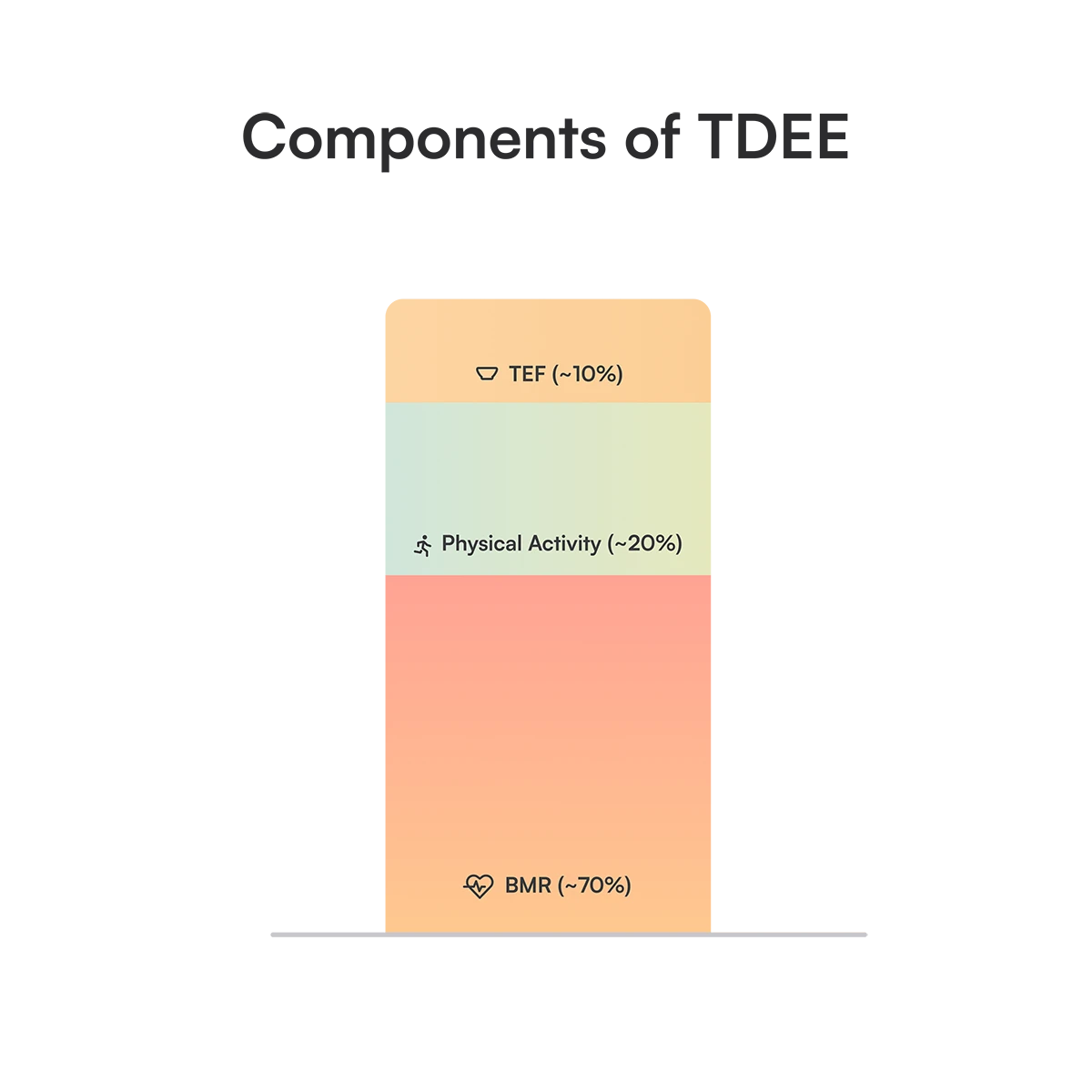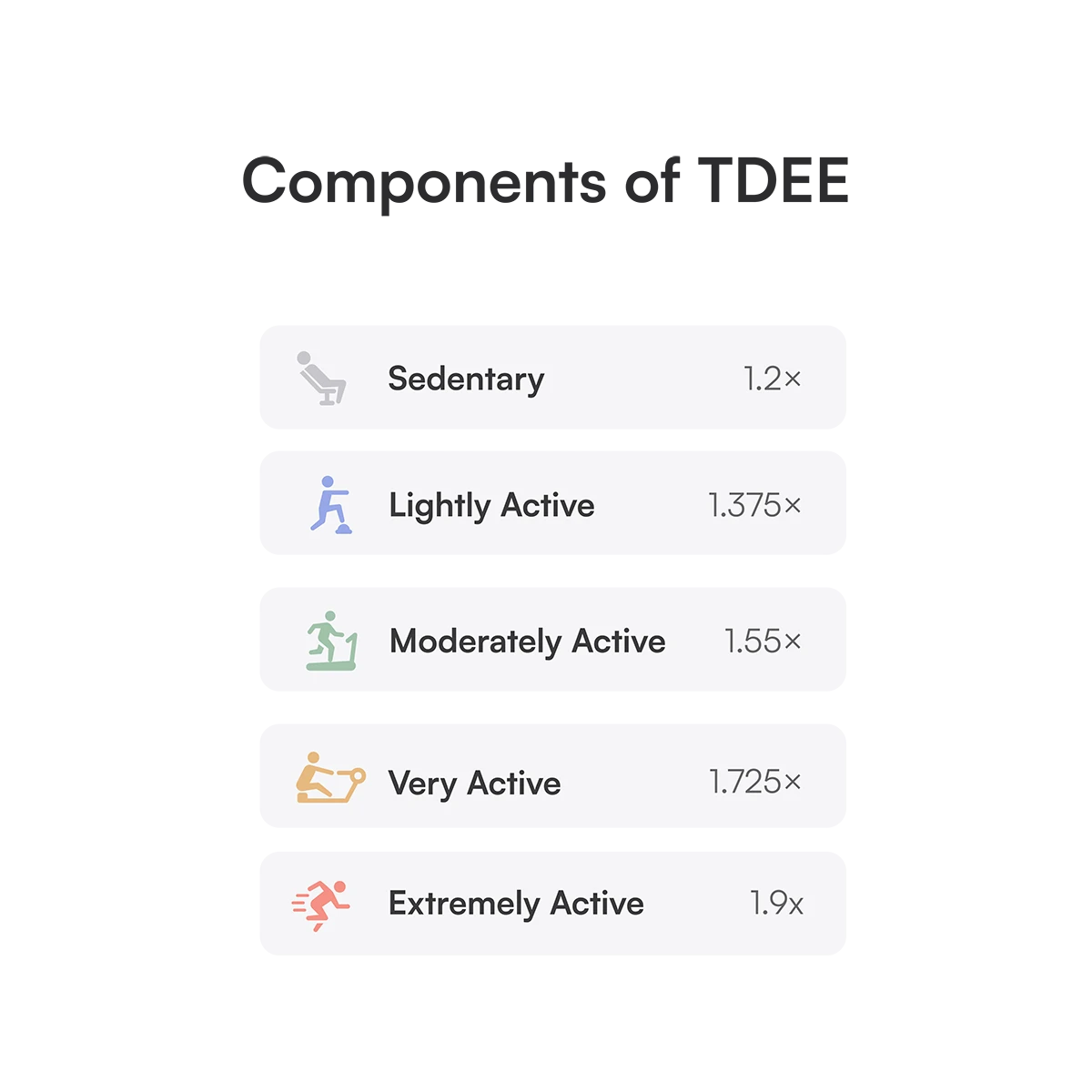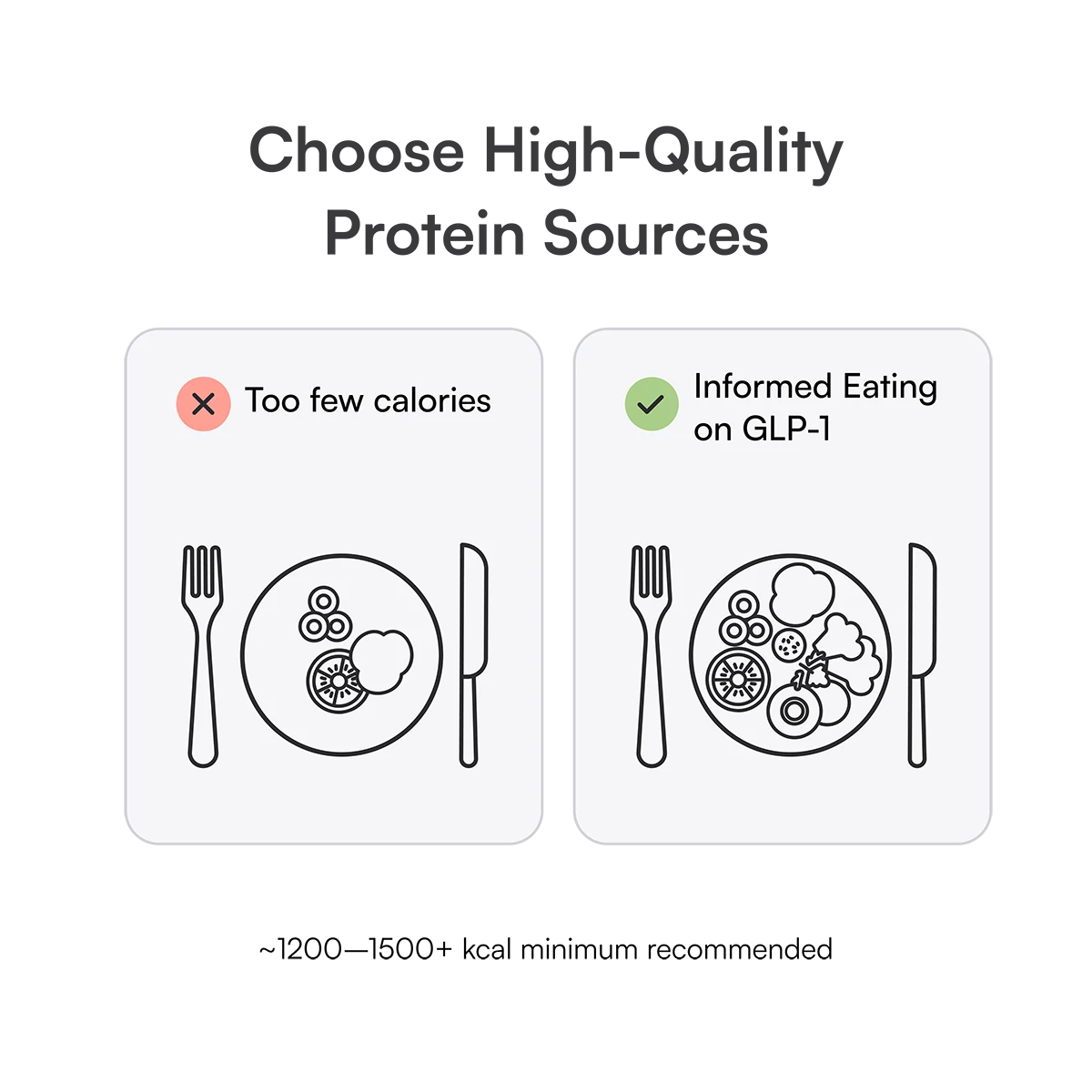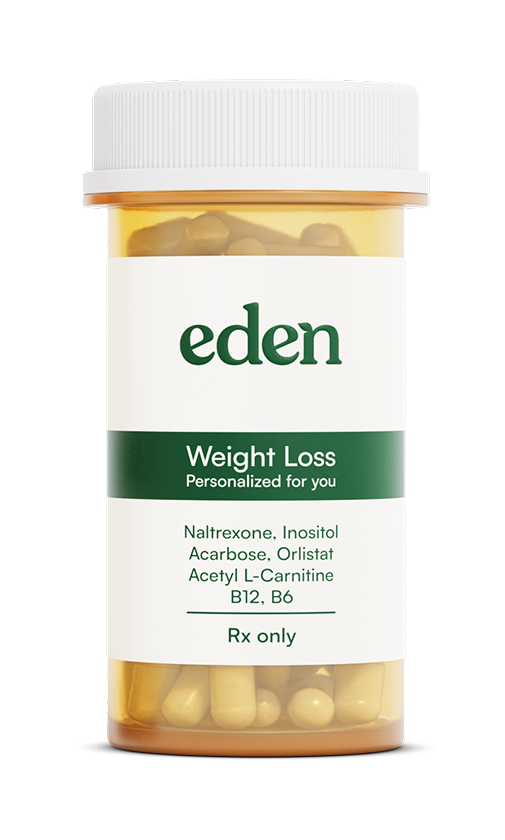Eden’s TDEE Calculator: Understanding Your Total Daily Energy Expenditure
Total Daily Energy Expenditure (TDEE) is a key number for anyone looking to lose weight, gain muscle, or maintain weight. It represents how many calories you burn in a day, and knowing your TDEE can help you plan your nutrition accordingly. In this article, we introduce Eden’s free TDEE Calculator – an anonymous tool to estimate your daily calorie needs – and explain how to use it. We’ll cover some basics (like BMR and activity levels), show how to adjust calories for different goals, and even touch on why TDEE awareness matters for people using GLP-1 weight loss medications. Let’s dive in!
This calorie calculator is intended for informational and educational purposes only. The results are an estimate and are not intended to be a substitute for professional medical advice, diagnosis, or treatment.
What Is BMR (Basal Metabolic Rate)?
Before we talk about TDEE, it’s important to understand Basal Metabolic Rate (BMR). BMR is essentially the number of calories your body needs to perform basic life-sustaining functions at rest. In other words, BMR is the energy you’d burn if you literally stayed in bed all day without moving – the bare minimum your body requires for things like breathing, circulating blood, and cell production. BMR is different for everyone and is influenced by factors such as age, sex, weight, height, and muscle mass. It typically makes up the largest portion of your daily calorie burn (around 60–70% of your total energy use).
If you’re curious about your own BMR, Eden offers a BMR Calculator as well. You can use it to get an estimate of how many calories your body needs at rest. (For a deeper discussion on BMR and what affects it, see Eden’s BMR Calculator page.) Understanding your BMR gives you a foundation, because TDEE builds on that number by accounting for additional calories you burn through daily activities.
What Is TDEE?
TDEE stands for Total Daily Energy Expenditure, which is an estimate of the total number of calories you burn in a day. This includes all the energy your body uses in 24 hours from various sources. There are a few main components that make up TDEE:
- Basal Metabolic Rate (BMR): As explained above, BMR is the energy used to keep you alive at rest – your body’s “idle” calorie burn.
- Physical Activity: All the movement you do in a day adds to your calorie burn. This includes planned exercise (like workouts – sometimes called Exercise Activity Thermogenesis) and everyday activities such as walking, fidgeting, or doing chores (Non-Exercise Activity Thermogenesis). The more active you are, the more calories you burn.
- Thermic Effect of Food (TEF): Yes, even digesting food burns some calories! TEF is the energy your body uses to process and absorb what you eat. It usually accounts for around 10% of your daily calorie expenditure. (Fun fact: protein has a higher thermic effect than carbs or fat, meaning your body uses a bit more energy to digest protein-rich foods.)

All these factors together make up your TDEE. In formula form, you might see it written as:
TDEE = BMR + activity + TEF (and a small amount for other processes).
Practically, you don’t need to calculate each item separately. Instead, TDEE is usually estimated by taking your BMR and multiplying it by an activity factor that represents your lifestyle. This gives a good approximation of your daily calorie needs.
How Is TDEE Calculated? (BMR × Activity Level)
In most TDEE calculations, activity level multipliers are used to scale your BMR up to your actual daily burn. Once you know your BMR (either from a formula or using Eden’s calculator), you choose the multiplier that best matches your routine. For example, someone who sits most of the day and rarely exercises will have a lower multiplier than someone with a very active job or intense training routine. Here are the standard TDEE activity multipliers and what they mean:
- Sedentary
Little to no exercise (desk job): ~1.2× BMR - Lightly Active
Light exercise 1-3 days per week: ~1.375× BMR - Moderately Active
Moderate exercise 3-5 days per week: ~1.55× BMR - Very Active
Hard exercise 6-7 days per week: ~1.725× BMR - Extremely Active
Very intense exercise daily or physical job (Athlete level): ~1.9× BMR
Using these multipliers, you can calculate TDEE easily. For instance, if someone’s BMR is 1500 calories and they have a moderately active lifestyle (about 3–5 workouts a week), their TDEE would be approximately 1500 × 1.55 ≈ 2325 calories per day. Eden’s TDEE Calculator does this math for you automatically: you input your personal data (age, sex, height, weight) to get a BMR estimate, then select your activity level, and it will output your estimated TDEE.

Keep in mind that TDEE is an estimate, not an exact science. It gives a good starting point, but actual daily burn can vary person to person. Factors like muscle mass, genetics, or even how honest we are about our activity level can make a difference. Still, knowing your TDEE is extremely useful for setting up a nutrition plan, because it represents roughly the number of calories required to maintain your current weight.
Using TDEE for Weight Maintenance
By definition, if you consume about the same number of calories as your TDEE, you should maintain your current weight. Weight maintenance means your calorie input (eating) matches your output (BMR + activity), so there’s no surplus or deficit. For example, if your TDEE is calculated to be 2500 calories/day, eating roughly 2500 calories a day would keep your weight steady (barring normal day-to-day fluctuations in water weight). Many people use TDEE as a reality check – if you’re gaining weight slowly, you might be eating above your TDEE without realizing it, and if you’re losing weight, you’re likely below TDEE.
Maintenance is important even for those actively losing or gaining weight. Typically, after a period of dieting or bulking, you may want to eat at maintenance for a while to let your body settle. Eden’s TDEE Calculator gives you that maintenance calorie number so you know what target to come back to for equilibrium. Remember that maintenance isn’t a single magic number but rather a range (maybe within ~100 calories) where your weight stays fairly constant.
Using TDEE for Fat Loss (Calorie Deficit)
If you want to lose body fat, you need to eat fewer calories than your TDEE – this is called a calorie deficit. When you consistently consume less than you burn, your body will tap into stored energy (body fat) to make up the difference, and you’ll lose weight over time. The TDEE Calculator helps by giving you a maintenance estimate; from there you can decide on an appropriate deficit. There are generally two approaches to calorie deficits: moderate and aggressive. Let’s explain the difference:
- Moderate Deficit (Sustainable Fat Loss): A common recommendation is about 500 calories per day below TDEE for a moderate deficit. This roughly translates to losing about 1 pound per week, since a pound of fat is ~3,500 calories. For many people, a 500-calorie deficit is challenging but manageable – you might feel a bit hungry, but it shouldn’t be overwhelming. For example, if your TDEE is 2500, a moderate cutting goal would be around 2000 calories per day. This level of deficit is often considered sustainable and is less likely to cause muscle loss or fatigue if done with proper nutrition. It’s a good starting point for slow and steady weight loss that fits into a balanced lifestyle.
- Aggressive Deficit (Faster Fat Loss): Some individuals opt for a larger calorie deficit of around 750–1000 calories below TDEE per day for faster results. A 1000 calorie daily deficit could lead to roughly 2 pounds of weight loss per week in theory. In our example of TDEE 2500, an aggressive cut might mean eating only 1500–1800 calories per day. This approach can yield quicker results on the scale, but it’s much more intense: you are more likely to experience hunger, low energy, and it’s harder to get all the nutrients your body needs when eating so little. Very aggressive deficits are typically short-term and not recommended for long periods, because they can strain your metabolism and lead to muscle loss or nutritional deficiencies if not carefully managed. Experts generally advise not going below about 1,200 calories per day for women or 1,500 for men without medical supervision, even on aggressive plans, as eating too little can be unsafe.

When using Eden’s TDEE Calculator, you’ll get your maintenance calories, and you can then decide how big of a deficit to aim for. Many people start with the moderate ~500 calorie deficit. For instance, Eden’s calculator may even show guidance like “To lose about 1 lb/week, eat approximately X calories” based on your TDEE (this kind of guidance is commonly provided by such tools). Always remember: slower, steady weight loss tends to be more sustainable. While an aggressive cut can be useful in certain scenarios, it’s generally wise to consult a healthcare provider or dietitian if you plan to go for a very low calorie intake. And listen to your body – if you feel excessively tired or unwell, you might need to ease up and choose a more moderate deficit.
Lastly, weight loss isn’t only about calories. The quality of those calories matters too. A deficit driven by eating nutrient-dense foods (lean proteins, veggies, whole grains, etc.) will feel better and preserve muscle mass more than a deficit from, say, skipping meals but eating junk food when you do eat. Eden’s tool is for educational purposes to give you numbers, but pairing those numbers with healthy eating habits will give the best results.
Using TDEE for Muscle Gain (Calorie Surplus)
What if your goal is to gain weight – specifically, to build muscle? In that case, instead of a deficit, you’ll want a calorie surplus, meaning you eat more than your TDEE. Building muscle requires extra energy (and protein) so that your body can create new tissue. However, just like with fat loss, there are slower vs. faster approaches to bulking:
- Lean Bulk (Moderate Surplus): A lean or “clean” bulk means using a small calorie surplus, often in the range of about +250 to +500 calories above your TDEE per day. This is a conservative approach to weight gain aimed at adding muscle with minimal fat. For example, if your maintenance (TDEE) is 2500 calories, a lean bulk might have you eating around 2700–3000 calories per day. With this strategy, you might gain on the order of ~0.5 to 1 pound per week. It’s slower, but the advantage is that most of that weight is more likely to be muscle (especially if you’re doing strength training) rather than fat. You’ll also find it easier to adjust if you start gaining too fast – you can tweak your intake by a couple hundred calories. During a lean bulk, it’s important to focus on high-quality foods (protein, complex carbs, healthy fats) to fuel muscle growth and recovery. Regular monitoring of your weight and body composition (and strength gains) is useful to ensure you’re on track.
- Aggressive Bulk (High Surplus or “Dirty Bulk”): This approach involves a larger calorie surplus, typically +500 to +1000+ calories above TDEE per day. Using the same example TDEE of 2500, an aggressive bulk could mean eating 3000–3500 (or more) calories daily. This can lead to faster weight gain – potentially 1+ pound per week – which can be appealing if you’re trying to put on size quickly. However, understand the trade-off: a big surplus almost guarantees that a significant portion of the weight gained will be fat, not just muscle. People who “dirty bulk” (eating anything and everything to gain weight) often find they get stronger and bigger faster, but later have to spend a long time cutting body fat. An aggressive bulk can be useful for very active individuals or hardgainers who struggle to gain any weight, but for most, it’s not usually necessary to eat that much above TDEE. If you do choose this route, go in with a plan: still prioritize protein and nutrient-dense foods, and maybe set a time limit (e.g., bulk for 2–3 months then re-evaluate). Watch out for excessive fat gain or health markers (like blood pressure or blood sugar) if your food choices aren’t the healthiest during a dirty bulk.
With Eden’s TDEE Calculator, you get your baseline maintenance calories, and from there you can decide on adding a surplus. A nice feature of knowing your TDEE is that it gives you a reference point – for instance, you might realize “Oh, my maintenance is ~2500, so eating 3000 is a few hundred extra per day.” Using that knowledge, you can adjust your meal portions or add a healthy snack or protein shake to hit the surplus. And just like with cutting, remember quality counts: a surplus from balanced meals will support muscle better than a surplus from just ice cream and soda, which might meet the calories but not the nutritional needs for muscle-building.
Tip: Whether cutting or bulking, it’s wise to increase your protein intake. When cutting, higher protein helps reduce muscle loss; when bulking, protein provides the building blocks for new muscle. Adequate protein (along with resistance training) is key for body composition goals, and it also influences your TDEE slightly by raising the thermic effect of food as noted earlier.
For GLP-1 Users: Why Calorie Awareness Still Matters
You may have heard about (or been prescribed) GLP-1 medications such as semaglutide (e.g., Ozempic® or Wegovy®) for weight loss. These medications are very effective at suppressing appetite and helping people eat less. If you’re using a GLP-1 as a weight loss tool, you might wonder: “Do I still need to think about calories or TDEE, since the medication is doing the work?” The short answer is yes – having an understanding of your TDEE is still important, even if you’re not “counting calories” in the traditional sense.
GLP-1 receptor agonists work by mimicking hormones that signal fullness; they slow down stomach emptying and reduce hunger cues. As a result, many people on GLP-1 therapy naturally eat much less than before. While you may not need to meticulously log every calorie (in fact, strict calorie counting isn’t always recommended for GLP-1 users if it adds stress), being calorie-aware can help ensure you’re still nourishing your body properly. Here’s why:
- Preventing Under-Eating: Some GLP-1 users find their appetite is so blunted that they barely feel like eating at all. This can lead to very low caloric intake. If you consistently eat far below your TDEE, you might lose weight rapidly, but you could also miss out on essential nutrients and risk side effects like fatigue, dizziness, hair loss, or other signs of under-nutrition. Knowing your TDEE gives you a benchmark for what “enough food” roughly looks like. For instance, if your TDEE is 2200 but you’re only eating 1000 calories because you’re never hungry, that’s a red flag. You may need to consciously increase your intake of healthy, protein-rich foods to meet your minimum needs. Calorie awareness in this context means making sure you don’t accidentally undershoot your body’s requirements to the point of malnourishment. Many experts suggest aiming for at least ~1200 calories per day (for women; ~1500 for men) even when on appetite suppressants, unless advised otherwise by a doctor.
- Preserving Muscle and Nutrition: During weight loss (with or without GLP-1 drugs), it’s crucial to get enough protein, vitamins, and minerals. If a GLP-1 helps you eat less, you have to “spend” your smaller calorie budget wisely. Use your TDEE (and perhaps the calculator’s suggested deficit) as a guide to distribute your intake. For example, if your TDEE is 2000 and you aim for ~1500 calories on the medication, make those 1500 count by including lean protein, vegetables, and whole grains. Recent research has shown that people on GLP-1 medications can fall short on certain nutrients and protein if they aren’t careful, because the reduced appetite leads to eating less of everything. Ensuring you hit a reasonable calorie floor and focusing on nutrient-dense foods will help preserve lean muscle and keep you healthier as you lose fat.
- Avoiding Over-Reliance on the Drug: Understanding energy balance (calories in vs. calories out) is empowering. Even with powerful medications, the fundamental reason weight comes off is because you’re eating fewer calories than you burn. Knowing your TDEE reminds you of this fact – it’s not “magic,” it’s science. Some people on GLP-1s might assume they will lose weight no matter what, but if you still consume more than your TDEE (it’s possible to out-eat the appetite suppression, especially with high-calorie foods), weight loss can stall. Tracking your intake against your estimated TDEE can help troubleshoot a plateau. Conversely, as we discussed, if you’re losing weight too fast, it might show you that your intake is way below TDEE and needs adjusting for safety. In short, TDEE is a useful compass for calibrating your eating, even when medication is curbing your hunger.

Ultimately, while GLP-1 medications can jump-start and assist with weight loss, you’ll get the best and healthiest results by pairing them with lifestyle awareness. Eden’s free TDEE Calculator can be a handy, non-judgmental reference for GLP-1 users to check in on their daily needs. It’s quick and anonymous – you can use it to ensure your calorie intake isn’t dropping into an extreme range and to remind yourself of the importance of balanced eating. Remember: medication is just one tool. Your overall nutrition still matters for your well-being. Use TDEE as part of that nutritional toolbox to stay on track during treatment. And as always, discuss with your healthcare provider or a dietitian about your diet while on GLP-1 therapy, especially if you have any symptoms of not eating enough.
Eden’s TDEE Calculator – Free, Fast, and Educational
Eden’s Total Daily Energy Expenditure Calculator is designed to be free to use, quick, and completely anonymous. In just a minute or two, you can input your information and get your estimated daily calorie burn, plus guidance tailored to your goal (whether it’s losing, gaining, or maintaining weight). There’s no signup required and no strings attached – the tool is there to help you make informed decisions about your nutrition. Whether you’re a fitness enthusiast fine-tuning your lean bulk, a busy professional trying to plan meals for weight loss, or simply curious about how many calories you burn in a day, the calculator can provide a helpful reference point.
We hope this overview has given you a clear understanding of what TDEE is and how to use it in your health journey. Knowledge is power: by knowing your BMR and TDEE, you can take control of your calorie intake in a way that aligns with your goals, be it fat loss, muscle gain, or weight maintenance. Eden’s calculator is a handy starting point – but remember that the number you get is an estimate, not a mandate. Listen to your body and adjust as needed. Combine that numerical insight with nutritious foods, regular exercise, proper sleep, and (if applicable) the guidance of healthcare professionals for the best results.
Disclaimer: Eden’s TDEE Calculator is a tool for educational purposes and general guidance only. It does not constitute medical advice or a personalized nutrition plan. Always consult with a qualified healthcare provider or nutritionist for individualized advice, especially if you have any medical conditions or specific dietary requirements.























